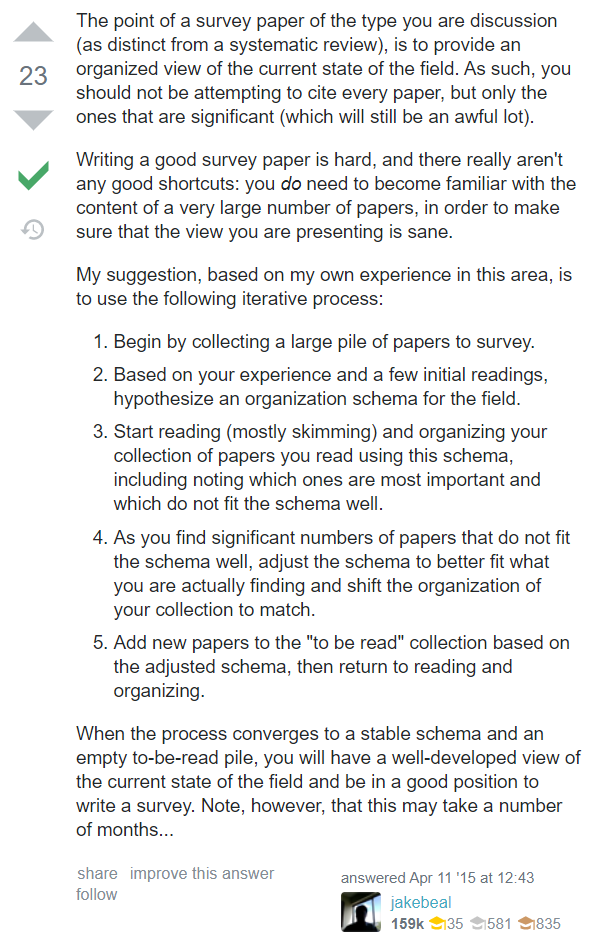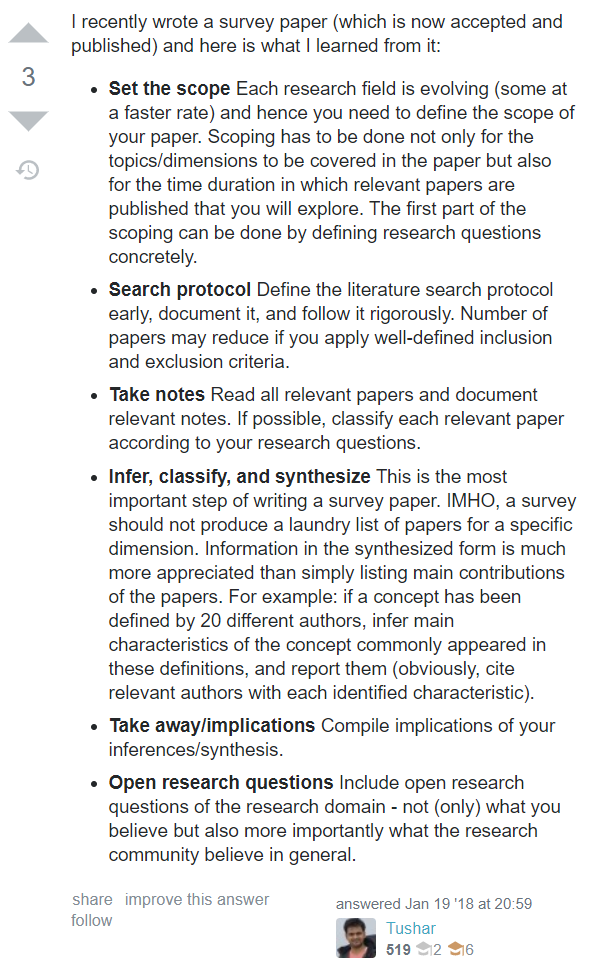Header Image: Unsplash: Patrick Tomass
Why Writing Survey paper
A Researcher begins his research journey by first writing a survey paper in the domain of his research. 1
Writing a survey paper helps a researcher in:
- Understanding his domain of research thoroughly
- Identifying the existing research gaps
- Understanding the various parameters and their role in solving the research problem
- Infrastructure and Data set requirements for research
What is expected in a Survey paper
A survey paper is a research paper which lists and analyses the latest research works in a particular research domain of interest. The survey paper derives some conclusions from the work carried out so far and provides new avenues for the future research. A good survey paper provides a concise but broad review of a domain that is accessible to a wide range of readers who are naive and willing to carry out research in the domain presented.
Challenge
Two biggest challenge in writing a survey paper:
- To pick representative papers from within the Research area. Identifying the papers having higher citations and which are published in conferences and journals of high reputation will have to be given higher priority for selection.
- To make the reader comfortable in reading and understanding analysis done for each paper
Should Do
- Pick at least 10-20 papers on a specific topic from the collected paper list.
- The papers selected should be a mix of papers including the base paper in the selected domain to the most recently published paper.
- Should have its own analysis on the significance of the approach and the results presented in each paper
- Give a critical assessment of the work that has been done
- Include a discussion on future research directions
- Give precise details of the experimental setup used for carrying out research in each paper
- Compare only those works which have common experimental platform or data set. Otherwise you have to recreate a common platform or use common data set and test the methodologies used in various platforms.
Key Sections
Title
The primary function of a Title is to provide clear summary of paper content.
A good title for a research paper is typically around 10 to 12 words long. A lengthy title may seem unfocused and take the readers’ attention away from an important point.
Usually a Title for a survey paper starts with:
- “A survey on …”
- “Recent trends in …”
- “Advances in …”
- “…: A Survey”
For example:
- “A Survey on leaf image analysis for bacterial disease detection”
- “Advances in leaf image analysis for bacterial disease detection”
- “Leaf image analysis for bacterial disease detection: A Survey”
Abstract
Abstract is a summary of a research paper describing the:
- Problem investigated
- The methods applied
- The main results and
- Conclusions
Abstracts are a good way to sum up the key contents of a paper, from the research that it uses to the ideas that you want to share with the reader. It is a single paragraph containing minimum 200 words up to 300 words. An abstract offers a preview, highlights key points, and helps the audience decide whether to view the entire work.
Key Terms
The purpose of keywords in a research paper is to help other researchers find your paper when they are conducting a search on the topic.
Keywords define the field, subfield, topic, research issue, etc. that are covered by the article. Keywords make your paper searchable and ensure that you get more citations. Thus, it is important to include the most relevant keywords that will help other authors find your paper.
Introduction
Introduction is used to:
- Explains how the research problem has been solved by various researchers
- Introduce the terminology of the field, describe what the various terms mean
The introduction does not have a strict word limit, unlike the abstract, but it should be as concise as possible. The introduction works upon the principle of introducing the topic of the paper and setting it into a broad context, gradually narrowing down to a research problem.
The first task of the introduction is to set the scene, giving your paper a context and seeing how it fits in with previous research in the field. The first paragraphs of your introduction, can be based around a historical narrative, from the very first research in the field to the current day. The entire introduction should logically end at the research question. The reader, by the end of the introduction, should know exactly what research issue you are trying to survey with your paper.
Survey
The survey has to be based on specific theme of research like:
Complexity of the problem
There can be various types of solutions for a given problem domain and the author has to organize them in the increasing level of complexity or scale. For example in Image Processing scene analysis is one of the core problems. It can start from simple gray scale image scene consisting of one or two objects of same shape with constant background to a complex image scene consisting of objects of various shapes with varying background color.
Static Vs. Dynamic
Many fields can be organized by static techniques, dynamic techniques, and even hybrid.
Segregating the Design Space
Many systems are made up of components.
Major Approaches in Specific Domain
History of Development
Such developments can be explained in chronological order.
Conclusion
The conclusion must answer the queries presented by your survey goals and objectives. The conclusion must be written in an interesting yet academic manner. No emotions should be attached to your conclusions but a commentary as a third person is required. Being the final portion of your survey report, the conclusion serves as the researcher’s final say on the subject of the survey. The conclusion must be a synthesis of the survey results with:
- interpretation of each result
- the proposal of a course of action based on result
- solution to the issues that emerged from the survey
The conclusion should be able to wrap up the entire survey from the formulation of survey goals up to the satisfaction of such objectives.
Some Suggestions
Reference
-
Vijay Rajpurohit, HOW TO WRITE BETTER SURVEY PAPER?, Research Voyage ↩
-
How to write a survey paper? Academia Stackexchange ↩ ↩2

